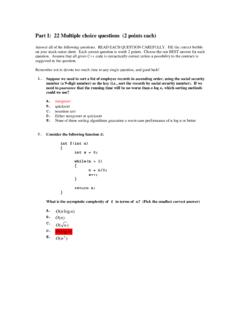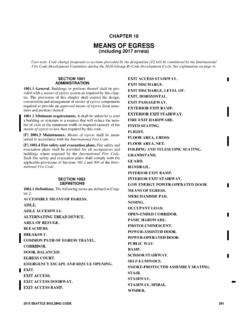Transcription of Graph Algorithm #1: Topological Sort
1 Lecture 20: Topo-Sort and Dijkstra's Greedy Idea Items on Today's Lunch Menu: Topological Sort (ver. 1 & 2): Gunning for linear time . Finding Shortest Paths Breadth-First Search Dijkstra's Method: Greed is good! Covered in Chapter 9 in the textbook R. Rao, CSE 326 Some slides based on: CSE 326 by S. Wolfman, 2000 1. Graph Algorithm #1: Topological Sort 322. 143. 321. 142 326. 370 341. Problem: Find an order in which all these courses can 378. be taken. 421. Example: 142 143 378 401. 370 321 341 322. 326 421 401. R. Rao, CSE 326 2.
2 Topological Sort Definition Topological sorting problem: given digraph G = (V, E) , find a linear ordering of vertices such that: for all edges (v, w) in E, v precedes w in the ordering B. C. A. F. D E. R. Rao, CSE 326 3. Topological Sort Topological sorting problem: given digraph G = (V, E) , find a linear ordering of vertices such that: for any edge (v, w) in E, v precedes w in the ordering B. C Any linear ordering in which A all the arrows go to the right F is a valid solution D E. A B F C D E. R. Rao, CSE 326 4. Topological Sort Topological sorting problem: given digraph G = (V, E) , find a linear ordering of vertices such that: for any edge (v, w) in E, v precedes w in the ordering B.
3 C. A. Not a valid Topological F sort! D E. A B E C D F. R. Rao, CSE 326 5. Topological Sort Algorithm Step 1: Identify vertices that have no incoming edge The in-degree of these vertices is zero B. C. A. F. D E. R. Rao, CSE 326 6. Topological Sort Algorithm Step 1: Identify vertices that have no incoming edge If no such edges, Graph has cycles (cyclic Graph ). B. C. A. Example of a cyclic Graph : D No vertex of in-degree 0. R. Rao, CSE 326 7. Topological Sort Algorithm Step 1: Identify vertices that have no incoming edges Select one such vertex Select B.
4 C. A. F. D E. R. Rao, CSE 326 8. Topological Sort Algorithm Step 2: Delete this vertex of in-degree 0 and all its outgoing edges from the Graph . Place it in the output. B. C. F A. D E. R. Rao, CSE 326 9. Topological Sort Algorithm Repeat Steps 1 and Step 2 until Graph is empty Select B. C. F A. D E. R. Rao, CSE 326 10. Topological Sort Algorithm Repeat Steps 1 and Step 2 until Graph is empty Select C. F A B. D E. R. Rao, CSE 326 11. Topological Sort Algorithm Repeat Steps 1 and Step 2 until Graph is empty Select C. A B F.
5 D E. R. Rao, CSE 326 12. Topological Sort Algorithm Repeat Steps 1 and Step 2 until Graph is empty Final Result: A B F C D E. R. Rao, CSE 326 13. Summary of Topo-Sort Algorithm #1. 1. Store each vertex's In- B. Degree (# of incoming C. A F. edges) in an array 2. While there are vertices D E. remaining: Find a vertex with A B. 0 D. In-Degree zero and output it 1 B C. Reduce In-Degree of all vertices adjacent 1 C D E. to it by 1 2 E. D. Mark this vertex (In- Degree = -1) 2 E. In-Degree Adjacency R. Rao, CSE 326. array 0 F list 14.
6 Topological Sort Algorithm #1: Analysis For input Graph G = (V,E), Run Time = ? Break down into total time required to: Initialize In-Degree array: O(|E|). Find vertex with in-degree 0: |V| vertices, each takes O(|V|) to search In-Degree array. Total time = O(|V|2). Reduce In-Degree of all vertices adjacent to a vertex: O(|E|). Output and mark vertex: O(|V|). Total time = O(|V|2 + |E|) Quadratic time! R. Rao, CSE 326 15. Can we do better than quadratic time? Problem: Need a faster way to find vertices with in-degree 0. instead of searching through entire in-degree array R.
7 Rao, CSE 326 16. Topological Sort (Take 2). Key idea: Initialize and maintain a queue (or stack). of vertices with In-Degree 0. Queue A F. 0 A B D. B C 1 B C. A F. 1 C D E. D E 2 D E. 2 E. In-Degree Adjacency R. Rao, CSE 326. array 0 F list 17. Topological Sort (Take 2). After each vertex is output, when updating In-Degree array, enqueue any vertex whose In-Degree has become zero Queue F B. dequeue enqueue 0 A B D. Output A. 0 B C. B 1 C D E. C. A F 1 D E. D E 2 E. In-Degree Adjacency R. Rao, CSE 326. array 0 F list 18. Topological Sort Algorithm #2.
8 1. Store each vertex's In-Degree in an array 2. Initialize a queue with all in-degree zero vertices 3. While there are vertices remaining in the queue: Dequeue and output a vertex Reduce In-Degree of all vertices adjacent to it by 1. Enqueue any of these vertices whose In-Degree became zero B C. A F. D E Sort this digraph! R. Rao, CSE 326 19. Topological Sort Algorithm #2: Analysis For input Graph G = (V,E), Run Time = ? Break down into total time to: Initialize In-Degree array: O(|E|). Initialize Queue with In-Degree 0 vertices: O(|V|).
9 Dequeue and output vertex: |V| vertices, each takes only O(1) to dequeue and output. Total time = O(|V|). Reduce In-Degree of all vertices adjacent to a vertex and Enqueue any In-Degree 0 vertices: O(|E|). Total time = O(|V| + |E|) Linear running time! R. Rao, CSE 326 20. Paths Recall definition of a path in a tree same for graphs A path is a list of vertices {v1, v2, , vn} such that (vi, vi+1) is in E for all 0 i < n. Chicago seattle Example of a path: Salt Lake City p = { seattle , Salt Lake City, Chicago, Dallas, San Francisco San Francisco, Dallas seattle }.
10 R. Rao, CSE 326 21. Simple Paths and Cycles A simple path repeats no vertices (except the 1st can be the last): p = { seattle , Salt Lake City, San Francisco, Dallas}. p = { seattle , Salt Lake City, Dallas, San Francisco, seattle }. A cycle is a path that starts and ends at the same node: p = { seattle , Salt Lake City, Dallas, San Francisco, seattle }. A simple cycle is a cycle that repeats no vertices except that the first vertex is also the last A directed Graph with no cycles is called a DAG (directed acyclic Graph ) All trees are DAGs A Graph with cycles is often a drag.
















